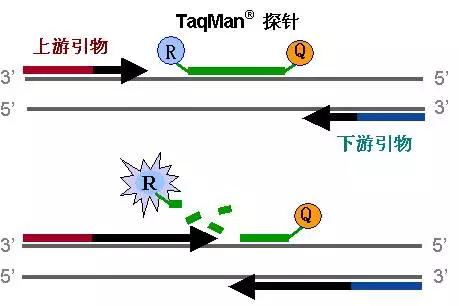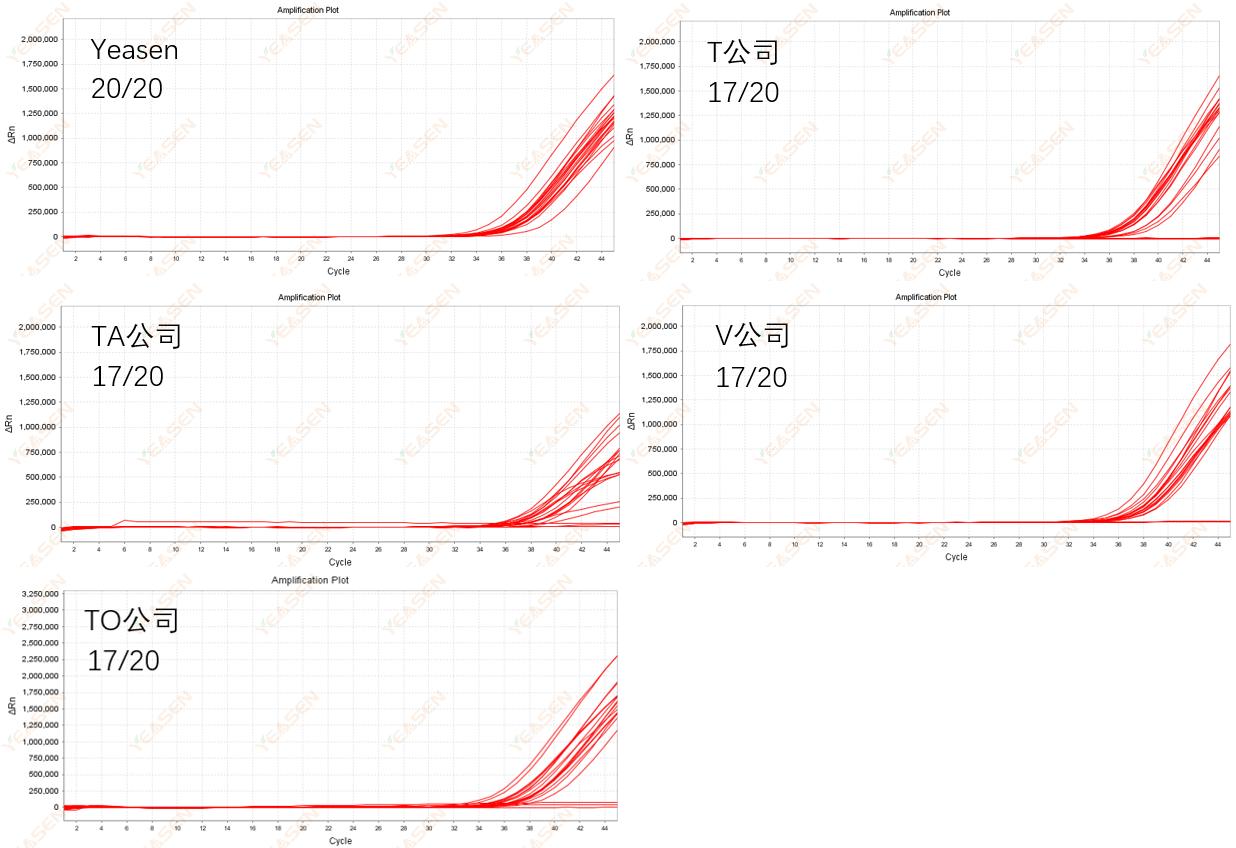Principle of TaqMan probe qPCR and its main application
Real-time fluorescence quantitative PCR (qPCR for short) is a method that adds fluorescent chemicals into the PCR reaction system and uses fluorescence signal accumulation to monitor the PCR amplification products in real time and perform quantitative analysis. According to different fluorescent chemicals used, qPCR can be divided into fluorescent dye method (represented by SYBR Green ⅰ method) and fluorescent probe method (represented by TaqMan method).
SYBR Green ⅰ dye method is widely used because of its advantages of simple operation and low price. But its biggest drawback is its lack of specificity, that is, the dye can bind to any dsDNA. Therefore, the appearance of non-specific amplification products in qPCR reaction will increase the fluorescence value and affect the accuracy of quantitative results, while the appearance of TaqMan probe method solves the problem of non-specificity of dye method well. Below, let's take a look at the basic principle and main application of TaqMan probe qPCR.
PART 01
Principle of TaqMan probe qPCR
TaqMan probe qPCR is a fluorescence detection method using TaqMan fluorescent probe. The basic principle of PCR amplification is to add a pair of primers and a specific fluorescence probe, which is labeled with a reporting fluorescence group and a quenchable fluorescence group at both ends. At the beginning, the probe was completely bound to any single strand of DNA, and the fluorescence signal emitted by the reporter group was absorbed by the quenched group, and the fluorescence signal could not be detected. PCR amplification, Taq polymerase 5 '- 3' exonuclease activity will probe enzyme degradation, made the report and the fluorescence quenching reactive separation, thus fluoresce, cutting the number of fluorescent molecular proportional to the number of PCR products, therefore, by measuring the fluorescence intensity in the PCR reaction system can achieve the goal of expanding incremental detection PCR products.
PART 02
Advantages of TaqMan probe qPCR
1. High specificity and accurate quantification
From the principle, it can be seen that the fluorescent probe only binds to the target sequence. Theoretically, the fluorescence signal of the probe method only comes from the target sequence, that is, it is not affected by non-specific products. Therefore, the specificity of qPCR of TaqMan probe method is very high and its quantitative accuracy is accurate.
2. The experiment is short in time
Due to the high specificity of the probe qPCR, there is no need to set the melting curve to detect the specificity of the amplified products, which greatly reduces the experimental time.
Compatible with multiple reactions
Fluorescence reporter groups with different wavelengths can label different probes. Therefore, probes with different fluorescence labels can be used to detect multiple targets simultaneously in the same reaction system to save experimental costs.
PART 03
TaqMan probe qPCR is mainly used
Because of these advantages, TaqMan probe qPCR has been widely used in scientific research and production practice. There are basic biology research, food detection, medical detection and diagnosis, especially in the medical detection and diagnosis has been vigorously promoted. Therefore, this paper focuses on its application in medical detection and diagnosis.
1 quantitative analysis of nucleic acid
Taqman qPCR technology can be used for quantitative and qualitative analysis of infectious diseases, including detection of pathogenic microorganism or virus content, detection of transgenic copy number of transgenic animals and plants, and detection of RNAi gene inactivation rate.
Analysis of gene expression differences
In many fields of modern biomedical research, from basic scientific research to practical application of drug research, the detection of gene expression is a basic and important work. Taqman qPCR technology can compare the expression differences of specific genes between samples treated with different treatments (such as drug treatment, physical treatment, chemical treatment, etc.), and the expression differences of specific genes in different phases.
Genotype/allele analysis
Single nucleotide polymorphisms (SNPs) are differences in individual DNA sequences caused by common substitutions of base pairs at the same location in the DNA sequence. SNPS are abundant in human genome and occur in high frequency. Detecting SINGLE nucleotide polymorphism is of great significance for studying individual susceptibility to different diseases or individual response to specific drugs.
Compared with traditional genotyping methods, Taqman qPCR has many advantages such as high efficiency and low cross-contamination, and has become one of the most common and convenient methods for SNP typing.
4 drug development research
In the development of new drugs, the rapid understanding of the impact of drugs on the disease process can save a lot of manpower, time and money for new drug development.
Compared with Elisa and other methods previously used, TaqMan qPCR can quickly, accurately and sensitively determine the content of pathogens in blood or tissues, providing a rapid and accurate evaluation for comparing the efficacy, dosage and duration of administration of different formulations.
5. Non-invasive prenatal examination
So far, people can not treat the genetic diseases caused by the change of genetic material, only through prenatal diagnosis, reduce the birth of sick babies, in order to prevent the occurrence of various genetic diseases.
For example, in order to reduce the birth of children with X-linked genetic diseases, fetal DNA can be isolated from the peripheral blood of pregnant women and the Y sex-determining region gene can be detected by TaqMan qPCR. In addition, TaqMan qPCR can also be used to detect toxoplasma gondii and syphilis in pregnant women, which can provide powerful help to find out the causes of unexplained abortion and habitual abortion, and greatly improve eugenics.
6. Tumor gene detection
Although the mechanism of tumor pathogenesis is not clear, it is widely accepted that mutations in related genes are the root cause of carcinogenic transformation. Increased expression and mutations of oncogenes occur early in many tumors.
TaqMan qPCR is an effective pre-detection and concomitant diagnostic technique for the prevention and treatment of cancer and malignancy. It can not only detect gene mutation effectively, but also accurately detect oncogene expression level.
At present, the expression of telomerase hTERT gene, chronic myeloid leukemia WT1 gene, tumor ER gene, prostate cancer PSM gene, tumor-related virus gene and other genes has been detected by this method.
7 Pathogen Detection
Taqman qPCR can be used for quantitative determination of a variety of pathogens such as human papillomavirus, human immunodeficiency virus, hepatitis virus, influenza virus and African swine fever virus. This technology solves the "window period" problem of immunological detection of pathogens, and can judge whether diseases are in recessive or subclinical state, which is suitable for early large-scale diagnosis of infectious diseases.
Taqman qPCR can also be used for virus typing, such as the identification of specific HPV types and variants, and targeted treatment to better prevent cervical cancer.
In addition, Taqman qPCR can determine viral load. Viral load is an important indicator to judge the efficacy of antiviral drugs in the course of monitoring. For example, drug load measurement of HIV requires Taqman qPCR technology to measure the amount of HIV RNA in blood, and the change of drug load can help judge the effect of HIV drugs.
PART 04
Application of Taqman qPCR Mix in the detection of African swine Fever virus
African swine fever (ASF) is an acute, virulent and highly contagious infectious disease caused by African swine fever virus (ASFV) infecting domestic pigs or wild boars. Its morbidity and mortality can reach 100%, seriously harming the global pig industry and causing incalculable economic losses.
At present, there is no vaccine and effective treatment for ASF. QPCR is an important tool recommended by OIE for routine diagnosis of ASF, and also the preferred detection technology in China under the current situation of ASF epidemic.
As a supplier of enzyme preparations deeply rooted in the upstream life science field, Yisheng Biology provides IVD enterprises with high-quality and cost-effective raw materials (including freeze-drying raw materials) for a long time, actively responding to the epidemic of African swine fever, and helping the efficient detection of African swine fever.
Hieff Unicon® Universal TaqMan multiplex qPCR master mix (Cat#11211)
A 2×Mix premixed reagent containing a genetically modified antibody thermally activated Taq enzyme and a deeply optimized multiple reaction buffer system can greatly improve the sensitivity and specificity of amplification.
Product features:
• Excellent amplification sensitivity: 3 copies/ reaction can be stable detection
• Super storage stability: 4℃, 25℃, 37℃ for 7 days, repeated freezing and thawing 50 times are stable performance
• High precision: CV < 1%
• Multi-platform application: applicable to all kinds of commercially available fluorescent quantitative PCR instrument
• Support multiple detection: up to 4-5 targets can be detected per well reaction
Partial performance display:
Ultra high sensitivity, 3 copies/ stable detection
Figure. The ASFV primer probe was used to test 20 multiple pores of ASFV plasmid (3 copies of final system), and the detection rate of each brand reagent was compared. It can be seen that the detection rate of Yeasen qPCR MIX is higher.
PART 05

